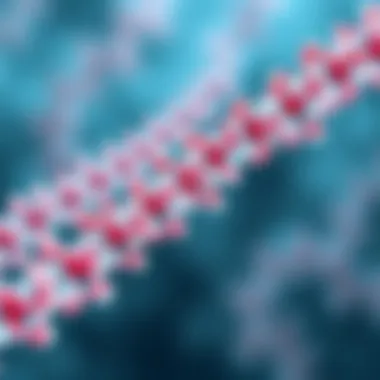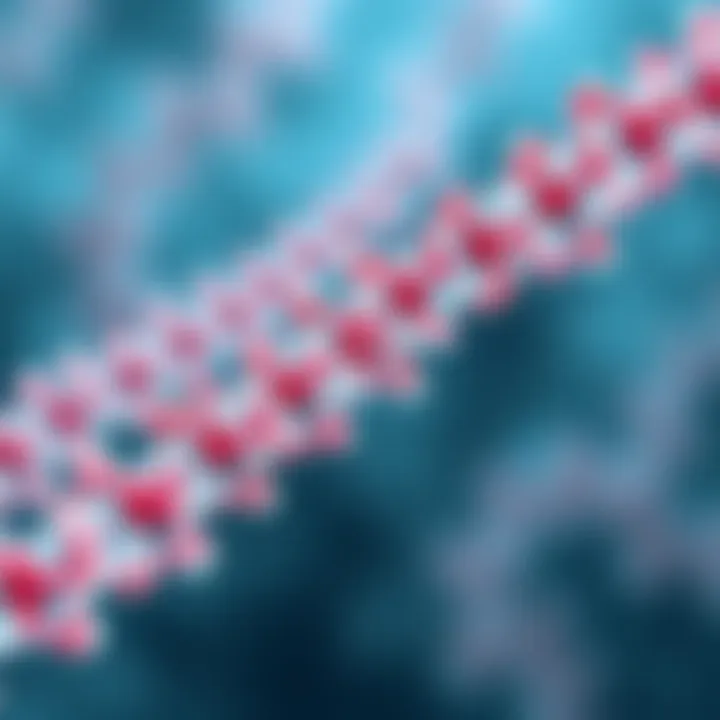CSP Antibodies: Mechanisms and Applications in Immunology


Intro
CSP antibodies are a fascinating piece of the immunology puzzle, representing a unique interplay between the immune system and pathogens. These antibodies—also known as cross-reactive anti-vector antibodies—play a crucial role in defending against infections by recognizing and targeting specific antigens. Understanding CSP antibodies is not just about the immune response; it opens doors to numerous therapeutic applications and potential breakthroughs in disease treatment.
In this article, we will embark on an exploration of CSP antibodies, delving into their defining attributes, their role within the immune system, and the practical implications of their use in medicine. From the mechanics that govern their functionality to the exciting avenues of future research, this comprehensive overview aims to provide both a foundational knowledge and an advanced understanding of CSP antibodies.
Preface to CSP Antibodies
Understanding CSP antibodies is essential due to their pivotal role in modern immunological research and therapeutic development. These antibodies not only serve as a crucial component of the immune system but also hold significant potential for application in various medical fields, including diagnostics and treatment. Their intricate mechanisms contribute to effective pathogen recognition and interactions that shape the body’s defense strategies. By diving into CSP antibodies, we can uncover their unique characteristics, applications, and the benefits they may provide in combating diseases.
Definition and Characteristics
CSP antibodies, or Cysteine-rich Secretory Protein antibodies, are specialized proteins produced by the immune system in response to antigens. Their primary role is to identify and neutralize these foreign invaders, thereby safeguarding the body against infections. These antibodies exhibit distinct characteristics; for instance, they often possess a high degree of specificity, allowing them to latch onto particular antigens with great precision.
In terms of structure, CSP antibodies typically feature a complex arrangement of heavy and light chains which form the functional regions known as paratopes. This structure equips them with the ability to recognize and bind to antigens effectively. Furthermore, CSP antibodies exhibit variability in their binding affinity; some may bind tightly, while others have a looser grip, influencing how effectively they can neutralize pathogens or block their effects.
"The ability of CSP antibodies to adapt and respond to diverse antigenic challenges reflects the ongoing evolutionary adaptations of the immune system."
History of CSP Antibody Research
The journey of CSP antibody research has been both remarkable and transformative. It can be traced back several decades when scientists first began to understand the importance of these antibodies in immune responses. Initial studies were primarily focused on their basic functions and interactions with antigens.
As time progressed, researchers delved into more advanced topics, seeking to comprehend the underlying molecular mechanisms driving these complex interactions. Notably, breakthroughs in techniques such as monoclonal antibody production in the late 20th century paved the way for a deeper exploration into the nuances of CSP antibodies. Today, research continuously expands, revealing the multifaceted roles these antibodies play in combatting infectious diseases and their potential in therapeutic applications.
As the field progresses, the significance of CSP antibodies grows, demanding a closer examination of their mechanics and implications in health and medical science.
The Structure of CSP Antibodies
The structure of CSP antibodies plays a crucial role in understanding their functionality and applications in the medical field. The intricate design of these antibodies not only influences their interaction with antigens but also determines their efficacy as therapeutic agents. By pinpointing the specific components that make up these antibodies, researchers can assess their performance in diagnostics and treatments. The uniqueness of CSP antibodies lies in their molecular architecture, which enables specific binding to pathogens, facilitating targeted immune responses. From a clinical standpoint, grasping the nuances of structure aids in optimizing their use in immunotherapy and vaccine development.
Molecular Composition
At the heart of every CSP antibody is its molecular composition, which primarily consists of four polypeptide chains: two heavy chains and two light chains, linked by disulfide bonds. The heavy chains are considerably larger, composed of a variable region and a constant region. The variable region is pivotal as it harbors the antibody's unique binding sites, determining its specificity towards particular antigens. In contrast, the constant region plays a role in defining the antibody's class and functionality.
The heavy and light chains together establish a structure commonly referred to as a Y-shape. This configuration is paramount because it allows antibodies to effectively engage with and neutralize pathogens. CSP antibodies, in particular, may exhibit variations in their variable regions which can optimize their binding capabilities and affinity for specific antigens.
To understand the molecular underpinnings of CSP antibodies, it’s essential to consider their glycosylation patterns as well. These sugar chains attached to the antibody molecules can influence stability, half-life, and even immune responses. Certain glycosylation patterns can enhance the antibody's ability to mediate interactions with various immune cells.
Binding Sites and Affinity
Another critical aspect of CSP antibodies is their binding sites, which dictate how effectively they can interact with antigens. The binding sites are formed by the unique arrangement of amino acids within the variable regions of the heavy and light chains. This arrangement is not random; instead, it is precisely shaped to accommodate specific molecular structures of target antigens.
The concept of affinity refers to the strength of the interaction between an antibody and its respective antigen. High affinity means that the antibody binds strongly to the antigen, which is particularly valuable in diagnostic and therapeutic applications.
"The right fit can determine the success of a therapeutic intervention; this highlights the importance of binding affinity in CSP antibodies."
In CSP antibodies, the notion of cross-reactivity often emerges. This is when an antibody designed to bind to one specific antigen also binds to similar antigens due to structural similarities. Although this can be advantageous in broad-spectrum therapies, it can also pose challenges, as unintended binding could lead to off-target effects.
The optimization of CSP antibodies involves harnessing their binding characteristics. Scientists explore various methods to enhance the affinity and specificity of these antibodies through techniques like phage display or hybridoma technology. Establishing an understanding of these binding dynamics provides a pathway to potential innovations in therapeutic interventions and diagnostic modalities concerning infectious diseases.
For those looking to delve deeper into the molecular composition and binding characteristics of CSP antibodies, consider reviewing detailed resources such as Wikipedia and Britannica. These sources offer foundational insights that can illuminate the complexities of antibody structure and function.


Mechanism of Action
The understanding of CSP antibodies, its mechanisms, is fundamental to appreciate how these entities engage in immune processes. The mechanism of action refers to the intricate ways through which CSP antibodies recognize and neutralize antigens, which are substances that the immune system identifies as foreign. This section peels back the layers of complexity, allowing us to grasp the inner workings that govern how these antibodies interact with pathogens.
Interaction with Antigens
CSP antibodies perform a crucial role in identifying and binding to specific antigens. Their structure is tailored to recognize and latch onto particular molecular signatures, which means they can act much like a key fitting into a lock. Once they bind to an antigen, a series of events are set into motion. Here's how this interaction is significant:
- Recognition and Specificity: The CSP antibodies have a unique ability to differentiate between self and non-self. This specificity minimizes collateral damage to host tissues, a common pitfall in immune responses.
- Neutralization: By binding to antigens, CSP antibodies can block their function and hinder their ability to infect cells. This is particularly critical in combating various pathogens, including viruses and bacteria.
- Flagging for Destruction: Following binding, these antibodies also signal other immune cells, such as macrophages and T cells, to come in and destroy the flagged invaders. This collaborative effort enhances the efficiency of the immune response.
To put it simply, the interaction between CSP antibodies and antigens sets the stage for an effective immune engagement, and without proper binding mechanisms, the immune response could be compromised.
"CSP antibodies act like sentinels of the immune system, always on the lookout for threats, ready to respond with precision."
Immune Response Pathways
Delving into immune response pathways highlights how CSP antibodies shape the body's defense against infections. Once these antibodies successfully bind to an antigen, various signaling cascades are triggered. These pathways involve intricate communication between immune cells and can be sketched out as follows:
- Activation of B Cells: Upon encountering an antigen, CSP antibodies can help activate B cells, which then proliferate and produce even more antibodies. This proliferation ensures a robust response, creating a reservoir of antibodies in circulation.
- Role of Helper T Cells: Concurrently, CSP antibodies can interact with Helper T cells, further amplifying the immune response. Helper T cells release cytokines that support B cell activation and enhance the killing functions of cytotoxic T cells.
- Memory Formation: An often-overlooked aspect is the formation of immune memory. Following a successful fight against an infection, some B cells become memory cells. These cells persist in the body, ensuring faster and more efficient responses to future exposures to the same antigen.
Through these pathways, CSP antibodies not only fight immediate infections but also equip the immune system to tackle future challenges more effectively. The resilience imparted by memory formation is invaluable, marking a significant evolutionary advantage.
In summary, the mechanisms of CSP antibodies are pivotal in ensuring an adaptive and robust immune response. Understanding these actions not only elucidates their role in health but also in the ongoing development of immunotherapies and vaccines targeted at leveraging these potent biological tools.
CSP Antibodies in Clinical Applications
CSP antibodies are gaining recognition not just in research settings but also in various clinical applications. This section sheds light on how these antibodies can be harnessed, emphasizing both their diagnostic and therapeutic value in modern medicine. As we explore the applications of CSP antibodies, their significance in enhancing patient care and advancing medical science becomes clear.
Diagnostics
The role of CSP antibodies in diagnostics is a prime example of their utility in clinical settings. Their specificity allows for the accurate detection of certain diseases, particularly those involving immune responses. These antibodies are engineered to bind to specific biomarkers, offering a window into the physiological state of the body.
For instance, CSP antibodies can be employed in serological assays to diagnose infection or autoimmunity. Using quantitative analysis, they can detect the presence and level of specific antigens or antibodies in a patient’s blood. This application not only aids physicians in making informed decisions but also streamlines the process of tracking disease progression.
Another area where CSP antibodies show promise is in the realm of point-of-care diagnostics. Rapid tests that use these antibodies can provide near-instantaneous results, crucial for conditions where time is of the essence, like in cases of infectious outbreaks. This quick feedback loop allows healthcare providers to take immediate action, potentially saving lives and mitigating the spread of disease.
Key Points about Diagnostics:
- Specificity: CSP antibodies can precisely identify antigens, reducing false positives or negatives.
- Speed: Point-of-care tests using CSP antibodies can deliver rapid results to aid quick clinical decisions.
- Tracking Disease: These antibodies help monitor disease progression by quantifying antibody levels over time.
Research Developments
Research into CSP antibodies holds significant promise for advancing our understanding of immunology and improving therapeutic strategies. With ongoing studies examining their unique properties, scientists are beginning to glimpse their potential roles in vaccine development, disease prevention, and treatment interventions. In a world increasingly challenged by emerging pathogens, CSP antibodies stand at the forefront of immunological research, likely holding keys to new advancements in global health.
Current Studies on CSP Antibodies
The focus of current studies is broad yet interconnected. Researchers are particularly interested in how CSP antibodies can enhance vaccine efficacy. One study published in the Journal of Immunology examined the use of CSP antibodies in the formulation of a malaria vaccine. The findings suggested that these antibodies could significantly boost the immune response, leading to more robust protection against the disease.
Moreover, the development of diagnostic tools utilizing CSP antibodies is another area of active research. By tailoring CSP antibodies for specific antigen detection, scientists hope to create rapid tests for infections. These efforts could vastly improve diagnostic accuracy and speed, promoting timely interventions for patients.
"The exploration of CSP antibodies in vaccine formulations represents a frontier that could reshape how we combat infectious diseases."
Innovations and Future Directions


As we look ahead, the future of CSP antibodies seems to flourish with potential innovations. One exciting direction being explored is the use of bioengineered CSP antibodies. Researchers are investigating how genetic engineering might enhance the antibodies' binding affinity and specificity to their target antigens, which could result in improved therapeutic outcomes.
Additionally, collaborations between academic institutions and biotechnology companies are paving ways for novel therapeutic applications. For instance, CSP antibodies are being studied in relation to chronic conditions such as autoimmune diseases. The adaptability of these antibodies suggests they could play a role not only in infectious diseases but also in modulating immune responses in a variety of maladies.
Another promising area is the integration of CSP antibodies into personalized medicine. Tailoring antibody therapies to individual patient profiles could significantly enhance treatment effectiveness and minimize side effects. This personalized approach could transform how healthcare providers manage diseases, making treatments not just more effective, but also more patient-centered.
Challenges and Limitations
In the realm of CSP antibodies, understanding the challenges and limitations they present is vital for advancing both research and clinical applications. As the field of immunology continues to evolve, scientists encounter numerous hurdles that hinder the progress and effectiveness of these antibodies. Recognizing these challenges not only helps to fine-tune ongoing research but also sparks innovative solutions to push the boundaries of what can be achieved.
Technical Challenges in CSP Antibody Development
Developing effective CSP antibodies is no walk in the park. Several intricate technical challenges surface during the antibody development process, which can significantly impact the outcomes of research and clinical use.
- Production Difficulties: One of the primary hurdles lies in the complicated nature of producing CSP antibodies. These antibodies often require specialized expression systems due to their complex structures. This complexity can lead to issues such as low yield or misfolding, making it tough to gather sufficient quantities for practical use.
- Specificity and Affinity Issues: Another key challenge is achieving the right balance of specificity and affinity. CSP antibodies need to bind tightly to their targets while avoiding unwanted cross-reactivity with non-targets. Striking this balance is crucial, as unwanted interactions can lead to inaccurate data and unreliable therapeutic outcomes.
- Stability Concerns: Furthermore, the environmental stability of these antibodies is a matter of concern. Under varying conditions, CSP antibodies can denature, compromising their effectiveness. So, researchers must invest time in identifying suitable conditions for storage and use, which complicates their application in real-world scenarios.
The resolution of these technical issues often involves meticulous optimization and iterative trial-and-error processes. While frustrating at times, overcoming these challenges can lead to significant advancements in the application of CSP antibodies.
Regulatory Hurdles
Navigating the regulatory landscape surrounding CSP antibodies is akin to walking through a maze—filled with complexity and the potential for dead ends. Regulatory hurdles present significant challenges that researchers and companies must address to bring these antibodies from the lab to the clinic effectively.
- Approval Processes: The journey toward approval for clinical use is fraught with intricacies. Regulatory bodies, such as the FDA and EMA, demand rigorous testing for safety and efficacy, which often requires extensive documentation and data. This can lead to lengthy timelines before a therapy can be considered viable.
- Ethical Considerations: There's a growing emphasis on the ethical side of research, driving the need for transparency and accountability. Researchers must navigate stringent guidelines that govern how studies are conducted, including aspects related to patient recruitment and informed consent. Failure to adhere to these guidelines can jeopardize projects and cause delays.
- Market Competition and Intellectual Property: Additionally, the competitive landscape can create barriers. Companies and researchers must carefully protect their intellectual property, which can lead to a host of negotiations and potential legal challenges that delay product development.
Thus, while regulatory hurdles can seem daunting, they play a crucial role in ensuring that CSP antibodies reach the market safely and effectively. Addressing these challenges head-on with a clear strategy can enable researchers to contribute meaningfully to the field of antibodies.
Comparative Analysis with Other Antibodies
The comparative analysis of CSP antibodies with other types of antibodies is crucial in understanding their unique characteristics and potential as therapeutic agents. As the field of immunology progresses, it's paramount to highlight these differences to inform both clinical applications and ongoing research. This section will delve into how CSP antibodies stack up against conventional antibodies, focusing on their mechanisms, functionalities, and the implications these factors have on health care solutions.
CSP Antibodies vs. Conventional Antibodies
CSP antibodies possess distinct properties that set them apart from conventional antibodies, such as IgG and IgM. For instance:
- Target Specificity: CSP antibodies might target specific antigens linked with certain diseases. In contrast, conventional antibodies often display broader specificities, making their applications less targeted.
- Rate of Production: When produced via recombinant DNA technology, CSP antibodies tend to be generated more swiftly than conventional ones, resulting in potentially quicker therapeutic interventions.
- Half-Life: The persistence of CSP antibodies in circulation can differ significantly from conventional antibodies. CSP antibodies often have a tailored design to ensure longer stability in the bloodstream.
- Mechanisms of Action: While conventional antibodies generally neutralize pathogens through direct engagement, CSP antibodies may deploy various stratagems, such as antibody-dependent cellular cytotoxicity (ADCC).
By discussing these comparisons, we can better understand how CSP antibodies can be utilized effectively against specific diseases.
Unique Benefits and Disadvantages
While CSP antibodies have shown promise in various applications, they also come with their own set of advantages and challenges that must be recognized.
Benefits:
- High Affinity and Specificity: CSP antibodies often demonstrate heightened affinity towards their targets, increasing their efficacy in diagnostic and therapeutic settings.
- Potential for Broad Applications: Their ability to target a narrow range of antigens means CSP antibodies can be developed for highly specific therapies, particularly in cancer immunotherapy or infectious diseases.
- Easier Engineering: The technology used in their creation allows for modifications that can enhance their performance.
Disadvantages:
- Cost and Accessibility: CSP antibodies can sometimes be more expensive to produce compared to traditional antibodies, impacting their availability in developing regions.
- Regulatory Challenges: As with most advanced therapeutics, navigating regulatory pathways can prove to be a significant hurdle for CSP antibodies.
- Limited Understanding of Side Effects: Given that CSP antibodies are still under extensive research, their long-term effects are not fully understood, posing risks for patients.
For further details on antibody research, you might find useful resources at Wikipedia and National Institutes of Health.
Understanding these nuances will empower researchers, clinical professionals, and regulatory bodies to make informed decisions regarding the development and application of CSP antibodies.


Ethical Considerations
CSP antibodies represent a significant advancement in the field of immunotherapy and disease prevention. However, as with any groundbreaking medical research, there are ethical concerns that must be addressed. These considerations not only influence the direction of research but also shape policies and guidelines that govern the use of these antibodies in clinical settings. Understanding the ethical dimensions of CSP antibodies is essential for both researchers and practitioners in the field, as they navigate the complex interplay between innovation, patient autonomy, and societal implications.
Ethical Implications in CSP Antibody Research
Research involving CSP antibodies raises multiple ethical questions that cannot be ignored. One prominent concern is the informed consent process. Researchers must ensure that participants fully understand both the potential benefits and risks associated with CSP antibody treatments. It is crucial for patients to know what they are getting into. Any ambiguity here can lead to mistrust and reluctance to participate in clinical trials.
Moreover, the very nature of target populations plays a role in ethical considerations. Many CSP antibody studies focus on vulnerable populations, such as those affected by infectious diseases in low-income countries. This necessitates a careful evaluation of whether the research is being conducted equitably and whether participants are benefiting fairly from the studies. Ethical research should strive for the advancement of medical science while prioritizing the welfare of all involved.
Furthermore, the issue of intellectual property cannot be overlooked. As CSP antibody research develops, questions arise concerning the ownership of these scientific discoveries. Who benefits financially from these breakthroughs? To what extent can research be shared or patented? These discussions around intellectual property influence not only the accessibility of the treatments but also the broader context of global health equity.
Patient Rights and Safety
At the heart of any medical research endeavor lies the fundamental duty to protect patient rights and ensure their safety. With CSP antibodies, this responsibility takes on several dimensions.
First and foremost, patient safety goes beyond physical health. Patients participating in studies should expect that their privacy and confidentiality be strictly maintained. The gathering and usage of personal data must align with ethical guidelines and legal requirements to protect individuals from potential breaches.
Secondly, there's a pressing need for ongoing monitoring of adverse effects related to the use of CSP antibodies. Clinical trials should incorporate robust mechanisms to report and analyze side effects. After all, it's not just about rushing treatments to market; it's about presenting safe and effective options to patients. This monitoring process must be transparent and communicated to all stakeholders involved.
Lastly, patient rights encompass the right to withdraw from studies at any time without penalty. Participants should be made aware that their choice to disengage from a study should never be questioned or discouraged. This aligns with the principle of autonomy, allowing patients to make informed decisions about their own health and participation in research.
In summary, ethical considerations in CSP antibody research are multifaceted and critical. They serve not just the immediate needs of scientific inquiry but also the broader implications of human rights and patient welfare. As the field evolves, ongoing dialogue and thoughtful consideration of these ethical challenges will shape the future of CSP antibodies and their role in global health.
CSP Antibodies and Global Health
CSP antibodies are gaining traction in the global health arena, not just as scientific curiosities but as key players in addressing some of the most pressing health challenges. Their implications extend far beyond individual treatment options, offering a glimpse into how they could reshape public health strategies worldwide. A robust understanding of CSP antibodies is essential for various stakeholders, including researchers, healthcare providers, and policymakers, to optimally leverage their potential benefits.
Impact on Vaccination Strategies
CSP antibodies play a critical role in vaccination strategies, helping to enhance the efficacy of vaccines against infectious diseases. As vaccine technology rapidly evolves, incorporating CSP antibodies into immunization programs can lead to more targeted and potent responses against pathogens. For instance, in regions heavily burdened by malaria, researchers have made substantial strides in incorporating CSP antibodies into malaria vaccines, aiming to boost antibody responses that thwart the parasite's lifecycle.
- Targeted Responses: CSP antibodies could improve the specificity of vaccine responses, which is crucial in areas with multi-valent infections. By fine-tuning vaccines to elicit CSP antibodies effectively, the body can mount a stronger offense against specific pathogens, potentially leading to vaccine breakthroughs in historically stubborn diseases.
- Adjuvant Synergy: The integration of CSP antibodies with proven adjuvants can enhance the immune response. Adjuvants, already integral to vaccine formulations, can work synergistically with CSP antibodies to promote a longer-lasting immunity.
- Universal Vaccination Strategies: In a practical context, CSP antibodies may contribute to the development of universal vaccines that can provide broader protection across various strains of a disease, which is particularly vital in the ever-changing landscape of global health threats.
"The future of vaccination may hinge on our ability to harness the power of CSP antibodies in innovative ways."
Role in Infectious Disease Control
The role of CSP antibodies in infectious disease control cannot be overstated. Their ability to bind to specific antigens presents novel possibilities in mitigating outbreaks and managing outbreaks that threaten global populations. Understanding this role invites an exploration into various ways these antibodies can influence disease dynamics:
- Early Detection: CSP antibodies can be pivotal in diagnostic tests to detect infections at an early stage, which is crucial for controlling disease spread. By identifying infections faster than traditional methods, public health initiatives can deploy timely interventions.
- Therapeutic Interventions: The therapeutic applications of CSP antibodies in treating infections are being actively researched. For instance, CSP antibodies can neutralize pathogens, offering a potential treatment avenue that complements existing therapies. By targeting the specific mechanisms of disease, CSP antibodies enhance treatment effectiveness.
- Monitoring Disease Resistance: In the context of rising antibiotic resistance, CSP antibodies can serve as vital tools to monitor the evolutionary adaptations of pathogens in real-time. Understanding how CSP antibodies interact with these evolving strains aids in formulating better strategies for vaccine development and public health approaches.
The End
In summary, the exploration of CSP antibodies reveals substantial implications for both theoretical and applied sciences in immunology. Understanding the mechanisms of these antibodies not only holds potential in enhancing diagnostics but also stimulates advancements in therapeutic strategies. CSP antibodies, by their very nature, are not just another tool in the immunological toolkit; they can pave the way for transformative approaches to disease management.
Summary of Key Findings
Several significant points have emerged from the discussions surrounding CSP antibodies:
- Molecular Distinction: CSP antibodies exhibit unique structural characteristics that differentiate them from conventional antibodies, thus influencing their functionality.
- Clinical Impact: Their application in diagnostics and therapeutics showcases their versatility, especially in targeting specific antigens linked with various diseases.
- Research Innovations: As new techniques and technologies develop, the landscape of CSP antibody research is rapidly evolving, indicating a promising future for their use.
- Global Health Relevance: CSP antibodies play a critical role in vaccination strategies and infectious disease control, contributing to public health on a broader scale.
The merging of these findings underscores the idea that CSP antibodies resonate beyond laboratory settings, impacting tangible health outcomes worldwide.
Future Prospects for CSP Antibodies
The future trajectory of CSP antibodies looks remarkably bright, with several avenues poised for exploration. Current research hints at the following trends:
- Enhanced Specificity and Affinity: Innovations in antibody engineering may lead to CSP antibodies with improved binding capabilities, significantly enhancing their therapeutic efficacy.
- Broader Applications: As studies continue to unearth their potential, there is anticipation that CSP antibodies could extend beyond their initial scope towards emerging diseases or novel therapeutic contexts.
- Integration with Technology: The collaboration with advanced technologies like CRISPR could enable more precise targeting approaches, creating new paradigms in treatment strategies.
- Increased Collaboration: Interdisciplinary partnerships among scientists, healthcare professionals, and regulatory bodies will likely spawn new studies aimed at better understanding and utilizing these antibodies.







